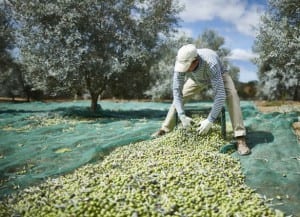
Last fall, we had the pleasure of attending an olive grove and olive oil facility for a guided tour to see first hand how hiqh quality olive oil is produced. Monterosa Olive Oil Farm in Moncarapacho, Portugal provides visitors with a delightful, informative tour accompanied by an olive oil tasting of their products.
In this article, I'll share our tour experience including what made the experience wonderful along with ideas that might help improve sideline tour businesses like those offered by Monterosa and increase revenue.
The Setting
We arrived to the tour after some difficulty. The Monterosa website did not include specific driving directions. We did receive an email with GPS coordinates and rudimentary directions, but unfortunately, I was not aware of how I could enter coordinates in my iPhone. (I have since learned how.) Don't let customers miss out on your tour because they couldn't find their way! Reduce confusion by including on your website and email confirmations your clearly, written directions along with a visual map to your location. (In your ThunderTix account, you may also display a map alongside your event listings via an optional information sidebar.)
 The grounds were quite beautiful and a tree lined drive led us to the grove and facility. We learned that the region had produced olives and oil since Roman times -- In fact, olives have been cultivated for 7000 years in the area -- and this grove's oldest trees dated back 800 years. Upon entering the plant facilities, Antonio Duarte, the owner and our soft-spoken tour guide, was busily preparing the staging area for the olive oil tasting. With nobody to greet us, we milled around the production equipment with other attendees awaiting the start of the tour.* Once ready, Antonio signaled for us to begin with a tour of the grove itself.
The grounds were quite beautiful and a tree lined drive led us to the grove and facility. We learned that the region had produced olives and oil since Roman times -- In fact, olives have been cultivated for 7000 years in the area -- and this grove's oldest trees dated back 800 years. Upon entering the plant facilities, Antonio Duarte, the owner and our soft-spoken tour guide, was busily preparing the staging area for the olive oil tasting. With nobody to greet us, we milled around the production equipment with other attendees awaiting the start of the tour.* Once ready, Antonio signaled for us to begin with a tour of the grove itself.
Olive trees can grow for thousands of years. As olive trees grow and age, they become hollow inside losing their initial older wood. During the grove tour, Antonio pointed out trees that were beginning to show deterioration of the inner part of the tree and even pointed out some that had become two entirely separate trees as the old wood gradually disappeared.
We learned that Spain and Portugal together produce significantly more olive oil than it's more famous counterpart, Italy. Throughout the area especially in the south, both wild and cultivated olive trees dot the landscape.
The Guided Tour
Antonio's grove grows 5 varieties of olives, and he described that the olive itself and the terroir of a given region, in this case, the Eastern Algarve, combine to produce distinct characteristics in olive oil just as it does with wine. His 50 acre grove lies close to the Atlantic Ocean and about 15 minutes from the picturesque seaside community of Faro. Monterosa specializes in artisanal oils with very limited production, and they are successfully creating prize winning olive oils in competition.
Unlike huge commercial manufactures utilizing mechanical pickers, Antonio's team picks the olives by hand providing two benefits: only the best unblemished and unbruised fruit provides the basis for their quality product, and the trees themselves are not stressed due to the potentially damaging methods employed by mechanical pickers. In commercial production of thousands of acres of trees, heavy equipment involves either the shaking of the entire tree at its trunk or "brushing" the tree limbs to remove olives.
Commercial Olive Oil Manufacturing
Sustainability at Monterosa
Monterosa strives to be as ecologically sound as possible. Antonio explained that the pruning and care of the trees produces a lot of compostable material. Additionally, the pressing of olives produces byproducts such as pits and the ground up remains of the fruit. What isn't shared with area farmers is composted back into the soil leaving nothing to waste.
 Olives are naturally drought tolerant making cultivation in the dry Algarve area one of the obvious choices in food production. Monterosa goes a step farther in their "green" efforts. They reduce water usage by allowing the grove floor to grow naturally helping to retain moisture unlike their commercial counterparts who "clean" the grove floor.
Olives are naturally drought tolerant making cultivation in the dry Algarve area one of the obvious choices in food production. Monterosa goes a step farther in their "green" efforts. They reduce water usage by allowing the grove floor to grow naturally helping to retain moisture unlike their commercial counterparts who "clean" the grove floor.
From the grove, we wound our way back to the facility. Unfortunately, we attended at a time that was post-production, so we were unable to see the plant in action. (Yes, the grove's plant lies dormant for most of the year!) Interestingly and as my companion learned after biting into a "wild" olive, olives are extremely bitter without processing and cannot be eaten straight off the tree. Antonio gave us a thorough overview of the fermentation and curing process, and how the machinery is used to press, strain and finally produce their small batch product. But the tasting would tell the story!
After The Tour: The Tasting
 Antonio gave each member of our 20 person group his five samples. He instructed us to first taste with our nose while swirling the cup as you would a fine wine. He then asked us what aromas we detected. Grassy, fruity, floral, pepper, or something else? Then we were asked to warm the small cups with our hands and see if the heat strengthened the aromas. Finally, the tasting! We were directed to noisily slurp each sample almost like whistling in reverse. This allowed us to mix the oil with air, and coat all of the taste receptors of our tongues to fully enjoy the delicious flavors. Each sample was followed by a pinch of sea salt to cleanse our palates.
Antonio gave each member of our 20 person group his five samples. He instructed us to first taste with our nose while swirling the cup as you would a fine wine. He then asked us what aromas we detected. Grassy, fruity, floral, pepper, or something else? Then we were asked to warm the small cups with our hands and see if the heat strengthened the aromas. Finally, the tasting! We were directed to noisily slurp each sample almost like whistling in reverse. This allowed us to mix the oil with air, and coat all of the taste receptors of our tongues to fully enjoy the delicious flavors. Each sample was followed by a pinch of sea salt to cleanse our palates.
At the close, Antonio invited us to consider a purchase. We came forward to pay for the tour and were delighted to learn it was free. Of course, we wanted to return to the U.S. with his olive oil but were afraid that we would be unable to take the bottles safely back by plane. We learned that Monterosa has a five container airline-ready sample pack in 3 ounce bottles. Best of all, the price was a mere 10 euros.
The Takeaway: Increase Guided Tour Revenue
Antonio might be missing an opportunity to add a little revenue to his bottom line. Tours take staff time which means the tour guide cannot spend time in production, improving the website, marketing their product or myriad other necessary business activities. What's more, tourists -- when not required to pay for reservations up front -- may be less apt to show up on their appointed tour date. In cases like this where tours are offered of facilities in the production of goods, why not consider tying the ticket to a "free sample" of the product? Antonio could easily sell tickets to an event that include a "tasting" and his 5-pack of bottles and even offer optional add-ons of additional bottles or logo t-shirts. (ThunderTix users, don't forget to add your own t-shirts via our Products module, so customers can buy your gear.)
Whatever decisions Antonio chooses in the tour part of his business, Monterosa is a fantastic visit and coupled with Museu de Portimao -- less than an hour away to the west -- will round out a great introduction to the importance and prominence of olives and olive oil along the beautiful Algarve coast.
Postscript: A big part of our culture here at ThunderTix is serving our customers promptly with a smile, and our clients frequently share their delight in that experience. The idea of being warmly welcomed is a trait many Americans embrace. I recognize that Monterosa is serving tourists from around the world and Americans are a small part of that group. That said, I believe all businesses everywhere should invite customers in with a smile to set the stage of their exceptional tours.
Hours of Operation - Be sure to call ahead!
Hours: Monday - Friday, 9:00 a.m. - 6:00 p.m.
Telephone: +351 289 790 440
Directions
Use the link above to learn how to enter the GPS coordinates in your iOS device which are: 37° 05' 19" N 7° 47' 15" W. Here is a link to the meeting location or you can click on the image below. Note the grove's rows of trees lined in parallel.
References:
Monterosa pamphlet 1
Monterosa pamphlet 2